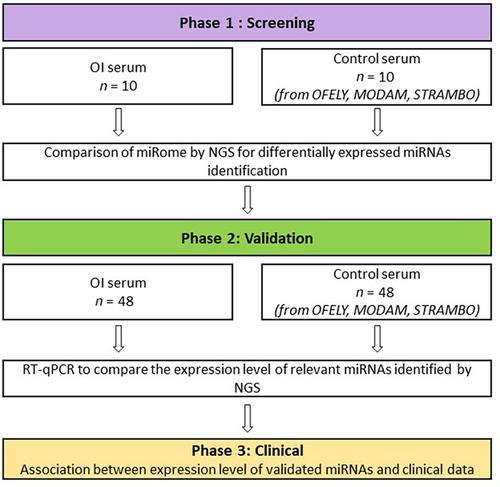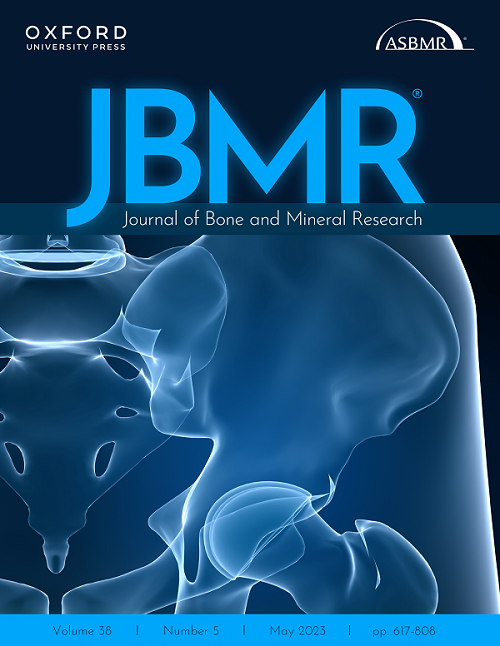Dysregulation of MicroRNAs in Adult Osteogenesis Imperfecta: The miROI Study
Alexandre Mercier-Guery, Marjorie Millet, Blandine Merle, Corinne Collet, Flora Bagouet, Olivier Borel, Elisabeth Sornay-Rendu, Pawel Szulc, Emmanuelle Vignot, Deborah Gensburger, Elisabeth Fontanges, Martine Croset, Roland Chapurlat
下载PDF
{"title":"Dysregulation of MicroRNAs in Adult Osteogenesis Imperfecta: The miROI Study","authors":"Alexandre Mercier-Guery, Marjorie Millet, Blandine Merle, Corinne Collet, Flora Bagouet, Olivier Borel, Elisabeth Sornay-Rendu, Pawel Szulc, Emmanuelle Vignot, Deborah Gensburger, Elisabeth Fontanges, Martine Croset, Roland Chapurlat","doi":"10.1002/jbmr.4912","DOIUrl":null,"url":null,"abstract":"<p>As epigenetic regulators of gene expression, circulating micro-RiboNucleic Acids (miRNAs) have been described in several bone diseases as potential prognostic markers. The aim of our study was to identify circulating miRNAs potentially associated with the severity of osteogenesis imperfecta (OI) in three steps. We have screened by RNA sequencing for the miRNAs that were differentially expressed in sera of a small group of OI patients versus controls and then conducted a validation phase by RT-qPCR analysis of sera of a larger patient population. In the first phase of miROI, we found 79 miRNAs that were significantly differentially expressed. We therefore selected 19 of them as the most relevant. In the second phase, we were able to validate the significant overexpression of 8 miRNAs in the larger OI group. Finally, we looked for a relationship between the level of variation of the validated miRNAs and the clinical characteristics of OI. We found a significant difference in the expression of two microRNAs in those patients with dentinogenesis imperfecta. After reviewing the literature, we found 6 of the 8 miRNAs already known to have a direct action on bone homeostasis. Furthermore, the use of a miRNA-gene interaction prediction model revealed a 100% probability of interaction between 2 of the 8 confirmed miRNAs and COL1A1 and/or COL1A2. This is the first study to establish the miRNA signature in OI, showing a significant modification of miRNA expression potentially involved in the regulation of genes involved in the physiopathology of OI. © 2023 The Authors. <i>Journal of Bone and Mineral Research</i> published by Wiley Periodicals LLC on behalf of American Society for Bone and Mineral Research (ASBMR).</p>","PeriodicalId":185,"journal":{"name":"Journal of Bone and Mineral Research","volume":"38 11","pages":"1665-1678"},"PeriodicalIF":5.1000,"publicationDate":"2023-09-15","publicationTypes":"Journal Article","fieldsOfStudy":null,"isOpenAccess":false,"openAccessPdf":"https://asbmr.onlinelibrary.wiley.com/doi/epdf/10.1002/jbmr.4912","citationCount":"0","resultStr":null,"platform":"Semanticscholar","paperid":null,"PeriodicalName":"Journal of Bone and Mineral Research","FirstCategoryId":"3","ListUrlMain":"https://onlinelibrary.wiley.com/doi/10.1002/jbmr.4912","RegionNum":1,"RegionCategory":"医学","ArticlePicture":[],"TitleCN":null,"AbstractTextCN":null,"PMCID":null,"EPubDate":"","PubModel":"","JCR":"Q1","JCRName":"ENDOCRINOLOGY & METABOLISM","Score":null,"Total":0}
引用次数: 0
引用
批量引用
Abstract
As epigenetic regulators of gene expression, circulating micro-RiboNucleic Acids (miRNAs) have been described in several bone diseases as potential prognostic markers. The aim of our study was to identify circulating miRNAs potentially associated with the severity of osteogenesis imperfecta (OI) in three steps. We have screened by RNA sequencing for the miRNAs that were differentially expressed in sera of a small group of OI patients versus controls and then conducted a validation phase by RT-qPCR analysis of sera of a larger patient population. In the first phase of miROI, we found 79 miRNAs that were significantly differentially expressed. We therefore selected 19 of them as the most relevant. In the second phase, we were able to validate the significant overexpression of 8 miRNAs in the larger OI group. Finally, we looked for a relationship between the level of variation of the validated miRNAs and the clinical characteristics of OI. We found a significant difference in the expression of two microRNAs in those patients with dentinogenesis imperfecta. After reviewing the literature, we found 6 of the 8 miRNAs already known to have a direct action on bone homeostasis. Furthermore, the use of a miRNA-gene interaction prediction model revealed a 100% probability of interaction between 2 of the 8 confirmed miRNAs and COL1A1 and/or COL1A2. This is the first study to establish the miRNA signature in OI, showing a significant modification of miRNA expression potentially involved in the regulation of genes involved in the physiopathology of OI. © 2023 The Authors. Journal of Bone and Mineral Research published by Wiley Periodicals LLC on behalf of American Society for Bone and Mineral Research (ASBMR).
成人成骨不全症中微小RNA的失调:miROI研究。
作为基因表达的表观遗传学调控因子,循环微核糖核酸(miRNA)已在几种骨病中被描述为潜在的预后标志物。我们研究的目的是分三步鉴定可能与成骨不全(OI)严重程度相关的循环miRNA。我们通过RNA测序筛选了在一小群OI患者血清中与对照组相比差异表达的miRNA,然后通过RT-qPCR分析对更大患者群体的血清进行了验证阶段。在miROI的第一阶段,我们发现了79个显著差异表达的miRNA。因此,我们选择其中19个为最相关的。在第二阶段,我们能够验证大OI组中8个miRNA的显著过表达。最后,我们寻找了经验证的miRNA的变异水平与OI的临床特征之间的关系。我们发现,在牙本质发育不全的患者中,两种微小RNA的表达存在显著差异。在查阅文献后,我们发现已知的8种miRNA中有6种对骨稳态有直接作用。此外,miRNA基因相互作用预测模型的使用揭示了8种已确认的miRNA中的2种与COL1A1和/或COL1A2之间相互作用的100%概率。这是第一项建立OI中miRNA特征的研究,显示miRNA表达的显著改变可能参与OI病理生理学相关基因的调节。©2023作者。由Wiley Periodicals LLC代表美国骨与矿物研究学会(ASBMR)出版的《骨与矿产研究杂志》。
本文章由计算机程序翻译,如有差异,请以英文原文为准。



